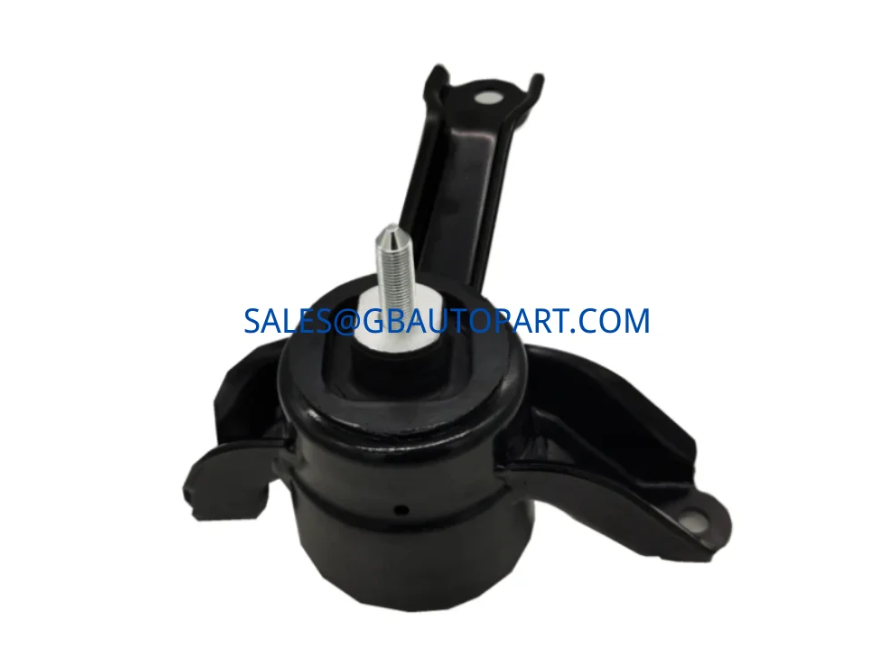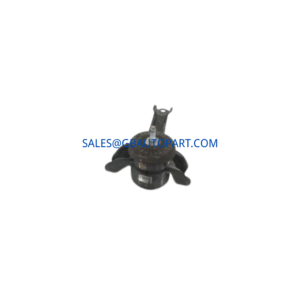
The modern automobile is a symphony of complex systems, where high performance and exceptional comfort are not mutually exclusive. However, achieving this harmony relies heavily on a class of components often overlooked: automotive rubber parts. These seemingly simple components are, in reality, highly engineered insulators, seals, and dampers. They are the unsung heroes that quietly absorb the stresses of the road and the engine, ultimately defining the quality of your driving experience.
Within this vital category, the engine mount stands as a paramount example. Specifically, the 21810-H9100 is a crucial part, typically identified as a Bracket Assembly-Engine Mounting for various Hyundai and Kia vehicle models. Its function goes far beyond merely holding the engine in place; it is a meticulously crafted bridge between the vehicle’s powerful engine and its delicate chassis. This deep-dive article is dedicated to unpacking the technology behind parts like the 21810-H9100, offering genuine value to professionals and enthusiasts seeking to understand the core of vehicle performance and durability. Understanding this component is key to appreciating the entire rubber parts domain.
The Foundation of Performance: Why Rubber Mounts are Critical
Automotive engines are powerful, but they are also generators of intense Noise, Vibration, and Harshness (NVH). This NVH includes the continuous rattling, shaking, and droning sounds that can turn a smooth ride into an unpleasant ordeal.
The Core Problem: Noise, Vibration, and Harshness (NVH)
The primary role of a rubber-metal part like the 21810-H9100 is to isolate the energy generated by the combustion process. Engine vibrations occur across three planes: vertical, lateral, and torsional. Without effective isolation, these forces would be directly transmitted into the vehicle’s frame, cabin, and steering wheel. Consequently, the driver and passengers would experience significant discomfort, and the long-term structural integrity of the vehicle would be compromised.
High-quality rubber compounds are uniquely suited for this task due to their viscoelastic properties. This means they exhibit both viscous (fluid-like) and elastic (solid-like) characteristics, allowing them to dampen energy efficiently across a wide range of frequencies and temperatures.
Focusing on the 21810-H9100: Design and Functionality

The 21810-H9100 part number signifies a specific, engineered solution designed to meet the rigorous demands of its application—typically the main engine mount for certain Hyundai Accent and possibly Kia Forte models.
Precision Engineering in the 21810-H9100
An engine mount is not simply a block of rubber bolted to metal. It is a sophisticated assembly, often referred to as a rubber-to-metal bonded component.
- The Metal Bracket: This structural element, which gives the part its “Bracket Assembly” designation, is crafted from high-strength steel or aluminum. It is engineered to handle the immense static weight of the engine and the dynamic forces during acceleration, braking, and cornering. The precise geometry of this bracket is essential for correct engine alignment.
- The Rubber Isolator: This is where the magic of NVH reduction happens. The rubber compound used in a part like the 21810-H9100 is a custom-formulated elastomer. It is not generic; rather, it is developed to a specific Durometer (hardness) and viscoelastic rate, which is tuned precisely to the unique vibrational signature of the associated engine (e.g., the 1.6L Gamma-II or similar engines in the applicable models). Its design may include specific voids or internal chambers to optimize its deflection characteristics under load.
Moreover, the bonding process between the rubber and the metal is one of the most critical aspects of its manufacture. This bond must withstand extreme operational conditions, including constant shear stress, high temperatures from the engine bay, and exposure to corrosive agents like oil, coolant, and road salt. Therefore, the selection of raw materials and the integrity of the bonding technique directly determine the mount’s lifespan and performance consistency.
Advanced Damping Technology
While some mounts are purely solid rubber-to-metal, many modern applications, including premium replacements for the 21810-H9100, incorporate hydraulic or vacuum-controlled technology.
- Hydraulic Mounts: These contain a fluid-filled chamber (typically glycol or silicone-based fluid) that connects two rubber diaphragms. The fluid passage is engineered to provide amplitude-dependent damping. At low amplitudes (typical cruising vibrations), the fluid flows slowly, resulting in soft, highly efficient isolation. However, during high-amplitude events (like hard acceleration or rough terrain), the fluid is forced through smaller orifices, increasing resistance and providing stiffer, more controlled engine movement. This dual-mode functionality ensures a smooth ride without sacrificing engine control during aggressive driving.
When replacing a worn mount, it is vital to check if the original 21810-H9100 specification called for a hydraulic design. Downgrading to a solid rubber mount can immediately and drastically compromise the NVH characteristics and the overall refinement of the vehicle.
Durability, Longevity, and Your Investment
The longevity of any automotive rubber part is intrinsically linked to the materials chosen and the environmental stresses it endures. For a primary engine mount like 21810-H9100, this is doubly true.
Factors Affecting Rubber Part Life
The high temperatures and chemical exposure in the engine bay are relentless adversaries of rubber. High-quality compounds, often utilizing EPDM (Ethylene Propylene Diene Monomer) or sometimes HNBR (Hydrogenated Nitrile Butadiene Rubber) for enhanced oil resistance, are specified to endure these harsh conditions.
- Heat Aging: Over time, continuous exposure to engine heat causes the rubber to harden, a process known as heat aging. As the material stiffens, its damping capacity is reduced, leading to an increase in cabin vibration—the classic sign of a failing mount.
- Chemical Degradation: Leaks from surrounding engine components (oil, transmission fluid, coolant) can break down the rubber polymers, causing them to soften, swell, and ultimately fail prematurely.
- Fatigue: Repetitive stresses from vehicle operation cause the rubber to gradually fatigue. Eventually, this fatigue can manifest as a complete tear in the rubber section or, critically, a complete separation of the rubber from the metal bracket.
The Value of Quality Replacement Parts
Choosing a high-quality replacement for the 21810-H9100 is a decision that impacts not just comfort but safety and performance. Lower-grade parts might initially fit but often use inferior, non-specification rubber compounds that fail far earlier, sometimes in less than a year.
By investing in parts that adhere strictly to OEM specifications, you ensure the correct Durometer hardness, optimal damping rate, and the necessary material resistance to heat and chemicals. This commitment to quality secures the engine’s stable positioning, preserves the vehicle’s original NVH ratings, and protects adjacent components from excessive vibratory stress. Ultimately, a quality part extends the service life of the vehicle and maintains a high level of driver satisfaction. This is the correct value proposition for the end-user.
Installation, Troubleshooting, and the Future of Rubber Parts
The correct installation of an engine mount is just as important as the quality of the part itself. Incorrect torque specifications or misaligned installation can immediately pre-load the mount with unnecessary stress, causing it to fail rapidly. It’s often recommended that a pair of mounts (or the entire set) be replaced together to maintain system balance, as a single new mount can be stressed by the deflection of its older, worn counterparts.
Troubleshooting Failed Mounts
Users experiencing any of the following symptoms should immediately suspect a failed 21810-H9100 or an adjacent mount:
- Excessive Vibration: A noticeable buzz or shake, particularly at idle or specific RPM ranges.
- Loud Clunking Sounds: Audible noise, especially when accelerating sharply, shifting gears (in manual transmissions), or hitting bumps. This often indicates the metal-to-metal contact of a completely separated mount.
- Engine Movement: Visible or excessive movement of the engine when revving the vehicle in park or neutral.
A Sustainable Future
Looking forward, the rubber parts sector is constantly innovating. There is a growing trend towards eco-friendly rubber formulations and the increased use of advanced thermoplastic elastomers (TPEs). These materials offer comparable NVH performance with reduced weight and a smaller environmental footprint, ensuring that components like the engine mount continue to evolve in line with the automotive industry’s drive toward sustainability and lightweighting. The fundamental function, however, remains timeless: to absorb the shake and maintain the structure, enabling a quieter, safer, and more comfortable driving experience.
Frequently Asked Questions (FAQ)
Q1: What is the main function of the 21810-H9100?
A: The 21810-H9100 is a specific Bracket Assembly-Engine Mounting used in various Hyundai and Kia models. Its main function is to securely hold the engine in place while simultaneously isolating the vehicle’s chassis from the engine’s intense vibrations and noise (NVH), ensuring a quiet and comfortable ride.
Q2: How can I tell if my 21810-H9100 engine mount is failing?
A: Common symptoms of a failing engine mount include: significant, unusual vibration felt through the steering wheel or floorboards, loud clunking or knocking noises during acceleration or shifting, and the engine shaking or moving excessively in the engine bay.
Q3: Should all my engine mounts be replaced at the same time?
A: While only one mount may have visibly failed, it is highly recommended to inspect and consider replacing all primary mounts (the set) simultaneously. This ensures balanced engine support, as a new mount operating alongside old, fatigued mounts can lead to premature failure of the new part due to unequal load distribution.
Q4: Are aftermarket 21810-H9100 parts as good as OEM parts?
A: The quality varies significantly. High-quality aftermarket parts manufactured to strict OEM specifications and using superior rubber compounds can be excellent, often offering the same performance and durability. However, low-cost alternatives may use inferior materials that degrade quickly, compromising vehicle performance and comfort. Always prioritize quality and material specification over a low price.






